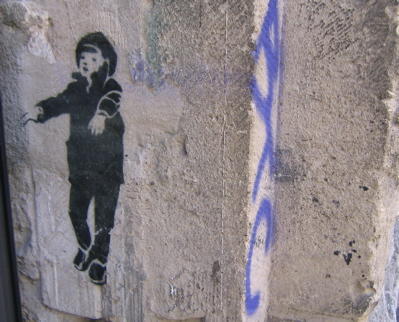 Yang’s work adapted as stencil art on a boxcar in Minneapolis, 2011. Photo: Paul Schmelzer
Yang’s work adapted as stencil art on a boxcar in Minneapolis, 2011. Photo: Paul Schmelzer
Sometimes in the life of images, derivatives end up eclipsing the original, leaving creators of unique works unacknowledged—and, often, unpaid—for their creative endeavors, even as spinoffs of their art zoom around the globe. And that’s the case with a 1960 photo by the late John Yang called Blindman’s Bluff. The first time I saw a version of Yang’s photo of a sleepwalking boy was in 2005 when I spotted a stencil rendering of it outside an art squat in Berlin. I quickly learned that it was wha the band calls an “adaption” [sic] of Yang’s photo, used to promote the Icelandic band Sigur Ros’ album ( ). I forgot about the image until I noticed another stencil version of it on a boxcar in Minneapolis earlier this month. It’s showed up in Reykjavík, Melbourne and elsewhere—likely by artists who know little, if anything, about the original.
Determined to figure out the back story of this arresting image, I contacted the estate of Yang, who passed away in September 2009. The reply I got back from his daughter was both beautiful and disconcerting.
 Yang’s work adapted as stencil art on a Berlin wall, 2005. Photo: Paul Schmelzer
Yang’s work adapted as stencil art on a Berlin wall, 2005. Photo: Paul Schmelzer
Born in Suchow, China in 1933, Yang emigrated first to the UK with his family, then, when he was six, to the United States. A U.S. citizen living in New York, he attended Harvard where he got his philosophy degree, then went on to architecture school at the University of Pennsylvania before being drafted into the military. Stationed in Germany, he played cello in the 7th Army Symphony and performed throughout Europe, according to his daughter, Naomi Yang, herself an artist (graphic design) and musician (Galaxie 500). It was in Strasbourg, France, just across the border from Germany, where he encountered the iconic sleepwalker: “The photo was not posed, my father was taking street scenes at the time and happened upon the boy,” Naomi writes in an email.
John Yang later focused his lens closely on details of urban life, including ornamental stonework on the facades of New York brownstones and memorial photographs on headstones at an Orthodox Jewish cemetery in Queens, but at the time he shot Blindman’s Bluff, he took a broader view, shooting documentary-style streetscapes. The photo was reproduced in the Time/Life book Photographing Children, which Naomi surmises, is where Sigur Ros found it—and took it.
 Blindman’s Bluff, courtesy the John Yang Archives
Blindman’s Bluff, courtesy the John Yang Archives
“[Sigur Ros] did not ask permission and they have never paid for the usage of the photograph, which as a musician and a graphic designer myself, I really, really object to,” says Naomi, who is now half of the music duo Damon & Naomi. “Approaching their management for some compensation has just met with indifference.” (Interestingly, the one place Sigur Ros gives Yang credit is on Flickr, where the band’s composite of Yang's photo and the stencil is copyrighted and marked “all rights reserved.”)
Upon seeing the graffiti version of her father’s work, Naomi wrote, “Wow, that image really gets around.”
After retiring from his architecture practice in 1978, John Yang committed himself to photography full-time. His final project explored the remnant of Indian Ladder Trail, a path threading the ridge known as the Helderberg Escarpement, in John Boyd Thacher State Park, near Albany, New York. Near the end of his life, Yang conducted an interview—with himself—that was included in the catalog for the “Indian Ladder” series. His words reference the seemingly unpeopled cliffs of the park, which he photographed mainly from the shadows in a style that has echoes of Ansel Adams, whom he admired. But they could just as easily apply to that 1960 photo—much more resonant than later works it inspired—of a French boy, silently and undisturbed in his private world of sleep, walking down a rain-damp street:
Am I correct in noting that there is also an unearthly silence that can be heard in many of your photographs?
Could be. Someone once said that my pictures have a distinctive elegiac tone, that they are pictures taken in a minor key.
For more on John Yang, visit johnyangphoto.com.




























